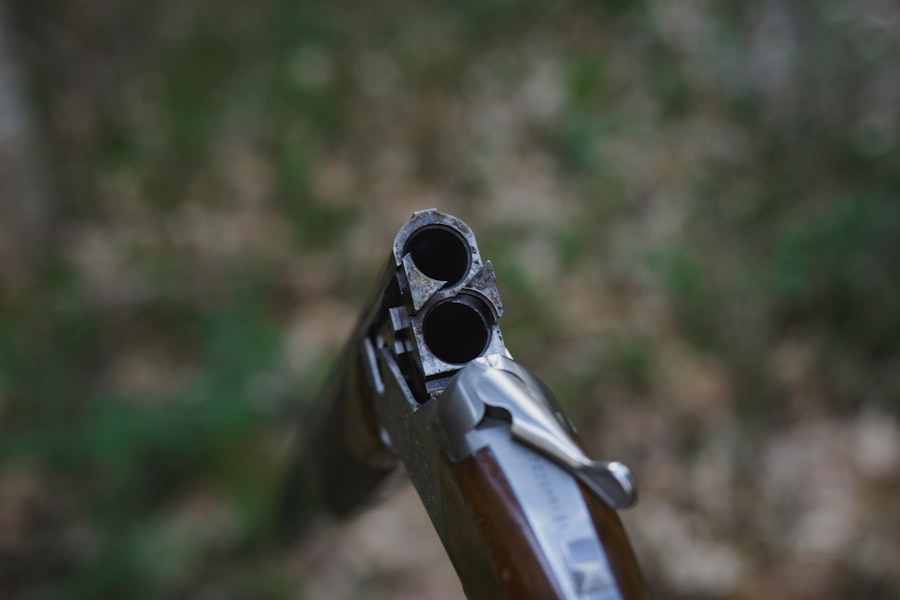The .45 ACP (Automatic Colt Pistol) cartridge is a staple in the world of firearms, renowned for its historical significance and robust performance. Developed by John Browning in 1905, the .45 ACP was designed for use in the Colt M1911 pistol, which became a standard-issue sidearm for the United States military during World War I and continued to serve in various capacities for decades. The cartridge is characterized by its large diameter, typically measuring .452 inches, and its relatively low velocity compared to other modern handgun cartridges.
This combination of size and speed results in a significant stopping power, making it a popular choice among law enforcement, military personnel, and civilian gun owners alike. The .45 ACP is often lauded for its effectiveness in self-defense scenarios due to its ability to deliver substantial energy upon impact. With bullet weights typically ranging from 185 to 230 grains, the .45 ACP can produce muzzle energies that rival those of some rifle cartridges.
This power, combined with its manageable recoil, allows shooters to maintain accuracy even under stress. As a result, the .45 ACP has earned a reputation as a reliable and formidable round for personal protection and competitive shooting.
Key Takeaways
- The 45 ACP bullet is a popular handgun round known for its stopping power and accuracy.
- Factors such as bullet weight, barrel length, and muzzle velocity can affect the distance a 45 ACP bullet can travel.
- The maximum effective range of a 45 ACP bullet is typically around 50 yards, but it can travel much farther under the right conditions.
- Long-distance travel of a 45 ACP bullet can pose risks to bystanders and property, making safe shooting practices crucial.
- Legal implications of a 45 ACP bullet traveling long distances can include criminal charges and civil liability for damages.
Factors that affect the distance a 45 ACP bullet can travel
Several factors influence the distance a .45 ACP bullet can travel, with the most significant being the bullet’s design, weight, and velocity at the moment of firing. The bullet’s design plays a crucial role in its aerodynamics; for instance, full metal jacket (FMJ) bullets are typically more streamlined than hollow points, allowing them to maintain velocity over longer distances. Additionally, heavier bullets tend to retain energy better than lighter ones, which can also affect how far they travel before losing effectiveness.
Environmental conditions are another critical factor that can impact the distance a .45 ACP bullet can travel. Wind speed and direction can alter the bullet’s trajectory, while atmospheric pressure and humidity can affect its velocity. For example, shooting at higher altitudes where air density is lower may allow a bullet to travel farther than it would at sea level.
Furthermore, temperature can influence the performance of both the powder charge and the bullet itself; warmer temperatures can increase the pressure within the cartridge, potentially leading to higher velocities.
Maximum effective range of a 45 ACP bullet

The maximum effective range of a .45 ACP bullet is generally considered to be around 50 yards for practical applications such as self-defense or target shooting. Within this distance, shooters can expect to achieve reasonable accuracy and stopping power. However, it is essential to note that while the .45 ACP can travel much farther than this range—potentially exceeding 1,000 yards under ideal conditions—its effectiveness diminishes significantly beyond 50 yards.
At this distance, factors such as bullet drop and loss of velocity become more pronounced, making it challenging for shooters to maintain accuracy. In practical terms, most law enforcement agencies and military units that utilize the .45 ACP do so with an understanding of its limitations. Training often emphasizes engagement distances within 7 to 25 yards, where the round’s stopping power and accuracy are maximized.
Beyond these ranges, while it may still be possible to hit a target, the likelihood of achieving a decisive impact decreases substantially. This understanding shapes how shooters approach their training and engagement strategies when using the .45 ACP.
Potential dangers of a 45 ACP bullet traveling long distances
| Distance | Potential Dangers |
|---|---|
| 1000 yards | Significant loss of velocity and energy, reduced accuracy, potential for injury if hitting a person or object |
| 1500 yards | Extreme loss of velocity and energy, minimal accuracy, potential for injury if hitting a person or object |
| 2000 yards | Minimal velocity and energy, highly inaccurate, minimal potential for injury if hitting a person or object |
One of the most significant dangers associated with a .45 ACP bullet traveling long distances is the risk of unintended injury or property damage. When fired into the air or at an elevated angle, bullets can travel considerable distances before descending back to the ground. The potential for a bullet to strike an unsuspecting individual or damage property increases dramatically as the distance increases.
This phenomenon is particularly concerning in urban environments where densely populated areas may be affected by stray bullets. Moreover, even when fired at ground level, a .45 ACP bullet can still pose risks if it travels beyond its intended target. The energy retained by the bullet upon impact can cause severe injury or death, especially if it strikes someone at close range or in a vulnerable area.
This reality underscores the importance of responsible shooting practices and awareness of one’s surroundings when handling firearms.
Legal implications of a 45 ACP bullet traveling long distances
The legal implications surrounding the use of a .45 ACP bullet that travels long distances can be complex and vary significantly by jurisdiction. In many areas, discharging a firearm in a manner that endangers others—such as firing into the air or at an elevated angle—can lead to criminal charges ranging from reckless endangerment to more serious offenses if someone is injured or killed as a result. Legal consequences may also extend to civil liability if an individual is harmed by a stray bullet.
Gun owners must be aware of local laws regarding firearm discharge and ensure they are following all regulations when using their weapons. This includes understanding where it is permissible to shoot and under what conditions. In some regions, there are specific restrictions on shooting near populated areas or during certain times of day.
Failure to adhere to these laws not only poses risks to public safety but can also result in severe legal repercussions for the shooter.
Tips for safe shooting and handling of 45 ACP bullets

Responsible Handling Practices
One fundamental rule is to always treat every firearm as if it is loaded. This mindset encourages responsible handling practices and minimizes the risk of accidental discharges.
Preparation and Familiarity
Shooters should ensure they are familiar with their firearm’s operation and maintenance before using it at the range or in any other setting. When shooting with .45 ACP ammunition, it is crucial to select an appropriate location that complies with local laws and regulations. Designated shooting ranges provide controlled environments where shooters can practice safely without endangering others.
Outdoor Shooting Safety
If shooting outdoors, ensure that there are adequate backstops and that no one is in the vicinity who could be harmed by stray bullets. Furthermore, wearing appropriate eye and ear protection is essential to safeguard against potential injuries from recoil or noise.
Comparison of the 45 ACP bullet to other handgun bullets in terms of distance traveled
When comparing the .45 ACP to other popular handgun cartridges such as the 9mm Parabellum or .40 S&W, several distinctions emerge regarding distance traveled and overall performance. The 9mm Parabellum typically has a higher velocity than the .45 ACP due to its lighter bullet weight (usually between 115 and 147 grains). This increased velocity allows 9mm rounds to maintain energy over longer distances compared to the .45 ACP, which may result in greater effective ranges for certain applications.
Conversely, while the .40 S&W offers a balance between size and velocity—often weighing between 155 and 180 grains—it still does not match the stopping power of the .45 ACP at close ranges. However, like the 9mm, it may have an advantage in terms of distance traveled due to its higher initial velocity. Ultimately, each cartridge has its strengths and weaknesses depending on the intended use case; while the .45 ACP excels in delivering powerful impacts at close range, other cartridges may offer better performance over longer distances.
Conclusion and final thoughts on the distance a 45 ACP bullet can travel
Understanding the distance a .45 ACP bullet can travel involves considering various factors such as bullet design, environmental conditions, and intended use cases. While this cartridge is capable of traveling significant distances under ideal circumstances, its practical effective range remains around 50 yards for most applications. The potential dangers associated with long-distance travel highlight the importance of responsible firearm handling and adherence to legal regulations.
As with any ammunition type, education on safe practices is paramount for all gun owners. By prioritizing safety and understanding both the capabilities and limitations of their firearms, shooters can enjoy their experience while minimizing risks to themselves and others around them. The .45 ACP remains a powerful choice for many enthusiasts; however, responsible use is essential for ensuring that its legacy continues positively within both recreational shooting and self-defense contexts.
If you’re planning a multi-day trek and wondering how far a 45 ACP bullet can travel, you may also be interested in checking out this article on the best hiking backpack for multi-day trek. Having the right gear is essential for a successful hiking trip, just like understanding the capabilities of your firearm.
FAQs
What is the maximum range of a 45 ACP bullet?
The maximum range of a 45 ACP bullet is approximately 1.5 miles (2.4 kilometers) when fired at a 30-degree angle.
What factors can affect the distance a 45 ACP bullet can travel?
Factors such as the type of firearm, barrel length, bullet weight, powder charge, and environmental conditions can all affect the distance a 45 ACP bullet can travel.
Is it safe to shoot a 45 ACP bullet into the air?
No, it is not safe to shoot a 45 ACP bullet into the air as it can travel a significant distance and pose a danger to people and property when it falls back to the ground.
What are some safety precautions to take when handling a 45 ACP firearm?
When handling a 45 ACP firearm, it is important to always follow proper gun safety protocols, including keeping the firearm pointed in a safe direction, keeping your finger off the trigger until ready to shoot, and being aware of your target and what is beyond it.
Can a 45 ACP bullet penetrate walls and other barriers?
Yes, a 45 ACP bullet has the potential to penetrate walls and other barriers, so it is important to always be mindful of your surroundings and what is beyond your intended target.
